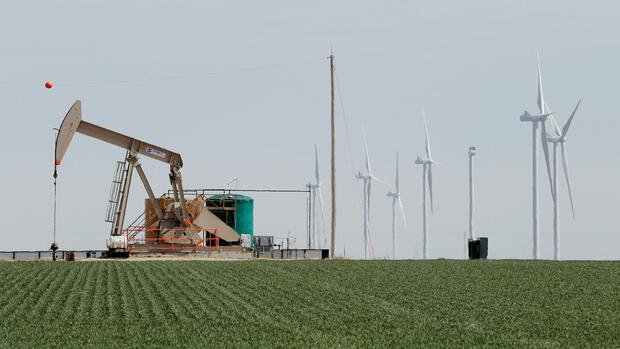new York In Austin, temperatures recently climbed to more than 42 degrees Celsius, and in Corpus Christi even to 50 degrees Celsius. In the US state of Texas, one heat record is chasing the next. When will the power grids collapse under the constant operation of millions of air conditioners? When do devastating power outages occur that cripple the state’s economy?
In the past there have always been large-scale blackouts in the energy grid in the USA – and they have caused massive damage.
But now it is precisely the expansion of wind and solar power that is stabilizing the system. Suddenly, Texas becomes the global blueprint for regions that suffer particularly from heat. In the southern hemisphere in particular, power grids repeatedly collapse during the hot months. Texas is now showing that renewable energies can become real risk killers at extreme temperatures.
The fact that Texas, of all places, is becoming a pioneer in the use of new energies is surprising at first glance. Because the US state is traditionally a state of oil production – and a state in which the conservative Republicans set the tone. And they are not necessarily considered ambitious advocates of climate protection.
But they, too, have recognized that in times of climate change, renewables play a key role in power supply. Scientist Josh Rhodes from the University of Texas at Austin: “If solar power generates a lot of electricity during the hottest part of the day, our supply from fossil fuels will not reach its limits as quickly.”
According to Doug Lewin, author of the Texas Energy and Power Newsletter, renewables have been able to provide 35 percent to 40 percent of electricity generation during the hottest hours. For comparison, on average over the past year, renewables in Texas accounted for 25 percent of all electricity generation.
Texas has almost tripled its solar capacity in the past three years and is currently building more plants. But even more important is wind energy, of which no US state produces more than Texas. “If Texas were its own country, it would be number five or six among wind energy producers in the world,” says Jon Elkind from the renowned Columbia University.
Texas is way ahead of California when it comes to alternative energies
Last year, Texas produced a total of 136,000 gigawatt hours of wind and solar power, according to the Energy Information Agency (EIA). California only managed just under 53,000 gigawatt hours.
Texas, whose area is almost twice the size of Germany, not only offers plenty of sun, but also very windy areas in the northwest. With 30 million people, the state is also sparsely populated. Many wind farms are on farmland, and cows often graze under the wind turbines.
>> Read More: Of all things Republican states rely on alternative energies
“Texas has vast tracts of usable land and a regulatory environment that’s very friendly to renewable energy projects,” said Eric Gimon, senior fellow at the San Francisco think tank Energy Innovation.
According to the energy expert Elkind from Columbia University, Republicans rely on alternative energies primarily for political reasons: “There are many Republicans who may doubt climate change, but who still prefer to be independent of other, insecure countries in terms of energy policy,” says Elkind. New sources of energy are a welcome additional opportunity – often in parallel with the extraction of coal, gas or oil.
Republicans have also learned that good business can be done with wind and solar power. At 367 megawatts, for example, the largest wind farm owned by the Danish Örsted group in Texas, the “Western Trail Wind Park”, is located on Stan Kroenke’s land of all places. The Republican billionaire owns, among other things, the football club Arsenal. According to Örsted, it supplies the Pepsico group, among others, from there.
Texas has nearly tripled its solar capacity in the past three years, but even more important is wind power, where Texas ranks first among the states.
(Photo: Bloomberg/Getty Images)
Pepsico is an example of how more and more companies are also pushing for alternative energies. Above all, the large technology groups demand that the energy is produced cleanly.
According to the American Clean Power Association, a total of 326 companies signed contracts for 77.4 gigawatts of solar and wind energy at the end of last year. That’s enough for thousands of data centers or 18 million American homes. In the first place are Amazon, Facebook mother Meta and Google. And most of the energy for them will come from Texas.
The US government sees its course confirmed
But renewable energies don’t just have friends in Texas. In fact, there have recently been attempts to reduce it significantly. Especially after the winter storm of 2001, the dominant Republicans tried to blame them for the power outages. Experts repeatedly pointed out that the disaster also had something to do with the failure of fossil energy infrastructure.
Earlier this year, Republicans even introduced a bill to the Texas Senate that would make it more difficult to build solar and wind farms. However, the draft did not make it through the state House of Representatives.
In any case, the Democratic Secretary of Energy in Washington, Jennifer Granholm, sees the latest developments in the hot summer of 2023 as confirmation of the US government’s climate-friendly course: “What keeps the lights on in Texas during the record heat waves? The renewables,” Granholm tweeted.
More: LNG boom made in USA – Demand from Europe is breathing new life into an entire region
